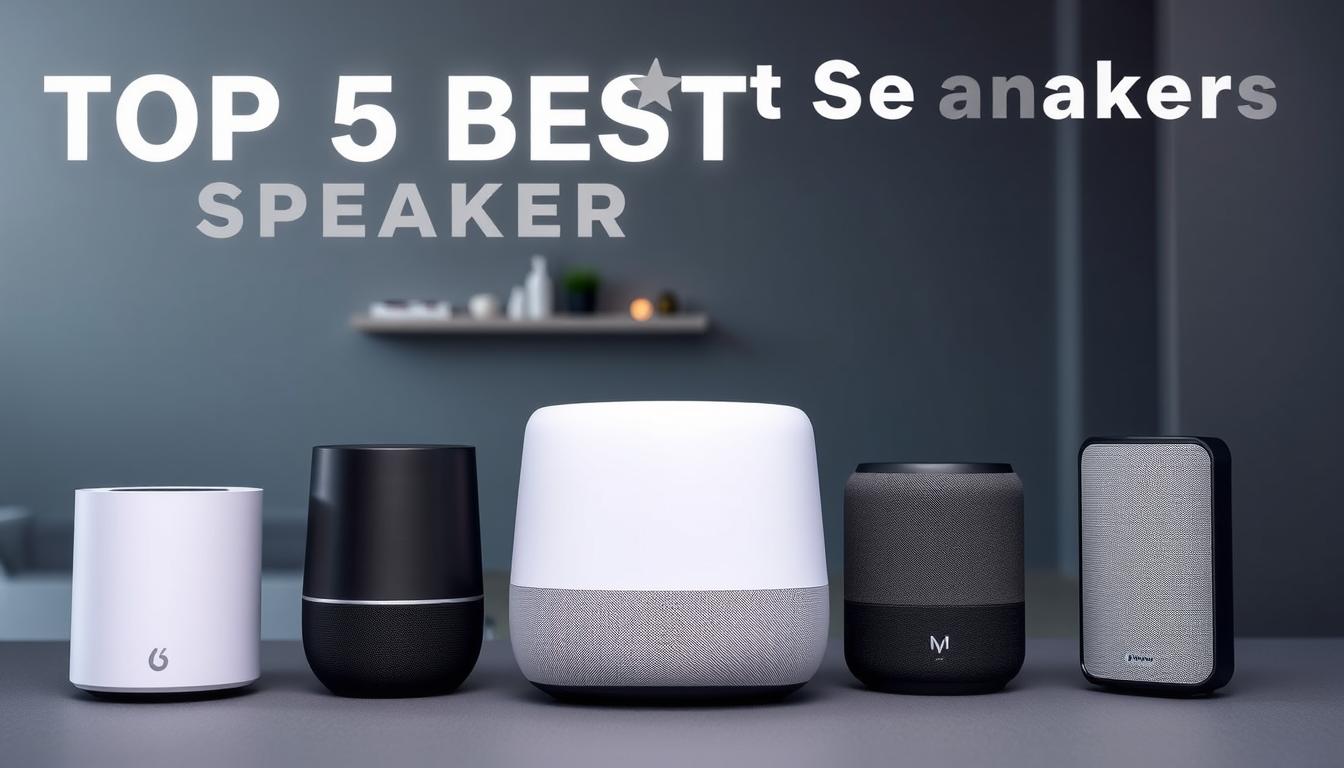The battle for your living space’s sound has heated up. Big names like Sonos, Bose, and Apple have turned single rooms into vast sound areas. The Sonos Era 300 offers 41% wider soundstages, says What Hi-Fi?. The Bose Smart Ultra Soundbar is praised for its smart setup in big rooms, WIRED notes.
Choosing the right system is key. Apple’s HomePod 2nd Gen works great with iPhones but not as well with Androids. Sonos, on the other hand, works with both AirPlay 2 and Google Cast. New wireless tech lets you sync sound across 12+ zones without lag, perfect for parties or enjoying music everywhere.
Voice assistants have become smarter. Amazon Alexa and Google Assistant can now manage your sound system easily. But, setting up these systems can be easy or hard, depending on the model.
Key Takeaways
- Professional testing by What Hi-Fi? and WIRED validates performance differences between premium models
- Proprietary ecosystems significantly impact device compatibility and user experience
- Next-gen wireless protocols enable seamless multi-zone synchronization
- Voice control capabilities now extend to complex audio network management
- Automatic room calibration separates premium devices from entry-level options
Understanding Multi-Zone Audio Networks
Creating whole-home audio is more than just adding speakers. It’s about setting up a system that works perfectly in every room. Modern multi-zone audio systems let you play different music in each room or have the whole house sound amazing. But, it takes some technical know-how to make it work.
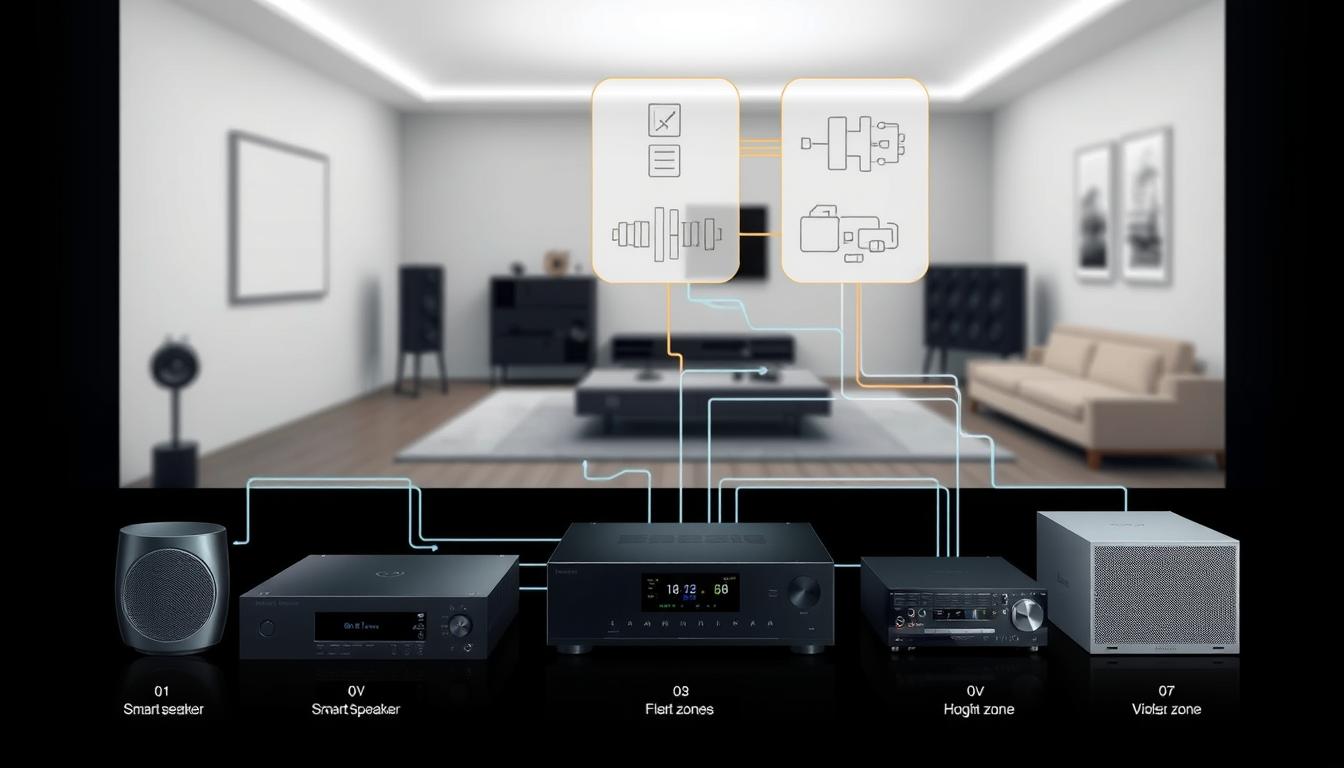
What Makes a True Multi-Room System
Seamless synchronization is key to top-notch systems. Brands like Sonos S2 and Bluesound Pulse M use dedicated wireless protocols to keep timing precise. This means no echo between zones.
The NYT Wirecutter’s 2023 review showed that closed systems, like Sonos, offer better integration. But open protocols, like AirPlay 2 and Chromecast, let you use more devices.
| Feature | Closed Systems | Open Protocols |
|---|---|---|
| Latency Control | ≤5ms | 15-30ms |
| Device Support | Brand-specific | Multi-brand |
| Setup Complexity | Automatic | Manual tuning |
| Update Frequency | Quarterly | Varies by manufacturer |
Key Components of Professional-Grade Audio
Three things make high-quality multi-zone systems:
- Amplifier headroom: 125% power above what speakers need
- Network prioritization: QoS-enabled routers for audio
- Clock synchronization: Precision time protocol (PTP)
Proprietary systems often have room correction software for better sound. DIY setups need separate parts like matrix amplifiers and signal processors. It’s a choice between ease and personal touch.
Selection Criteria for Network-Ready Speakers
Choosing the right speakers for a multi-zone audio setup is key. It’s about finding the perfect mix of cutting-edge tech and top-notch sound. Let’s explore what makes a speaker go from good to great.
Essential Connectivity Standards
Today’s wireless speaker networks need more than just simple pairing. They must handle streaming in multiple rooms at once. This requires advanced tech.
Wi-Fi 6 vs Bluetooth 5.3
Wi-Fi 6 is a game-changer for whole-home audio, supporting over 50 devices at once. Sonos’ Era 300 boasts 4x faster data transfer than older Wi-Fi systems, perfect for high-quality audio. Bluetooth 5.3, on the other hand, excels in portable settings, like JBL’s Authentics 200, which offers 3x longer range.
| Feature | Wi-Fi 6 | Bluetooth 5.3 |
|---|---|---|
| Max Bandwidth | 9.6 Gbps | 3 Mbps |
| Latency | <50ms | 100-300ms |
| Ideal Use | Whole-home systems | Portable pairing |
Matter Protocol Compatibility
The Matter 1.2 standard is a big deal for smart homes. It lets speakers like Sonos Era 300 connect to Alexa, Google Home, and Apple HomeKit without extra bridges.
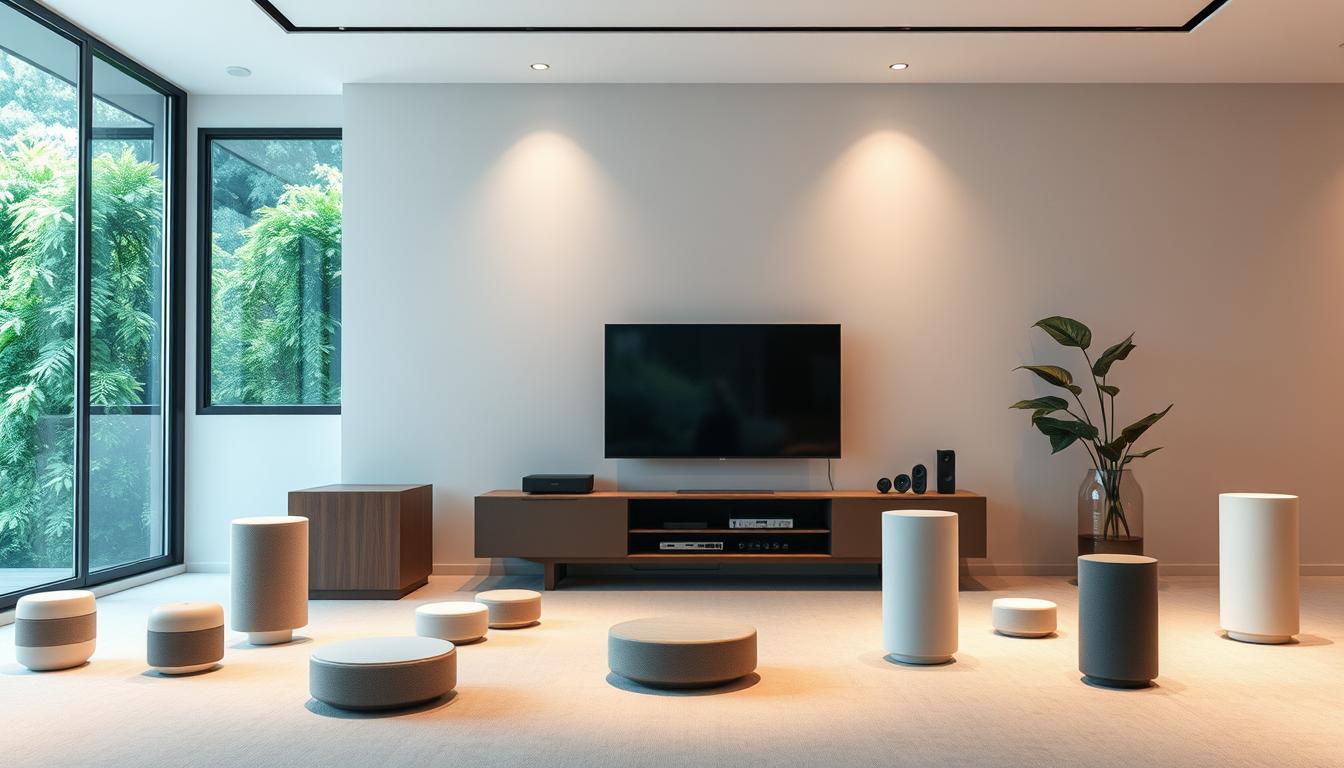
Sound Quality Benchmarks
Good sound is essential, not just connectivity. RTINGS’ lab tests highlight three key areas for multi-room audio:
- Frequency Consistency: Denon Home 350 keeps sound within ±2dB across rooms
- Total Harmonic Distortion: Top models keep distortion under 0.5% at 90dB
- Group Delay: Sonos Era 300 has just 12ms latency, which is almost undetectable
SoundGuys found the Apple HomePod 2nd Gen excels in mid-range clarity, great for voice content. For bass fans, the Echo Studio 2’s 5.25” woofer hits 40Hz, a rare feat in wireless speakers.
Top 5 Smart Speakers for Building a Multi-Zone Audio Network

Creating a seamless multi-room audio system needs speakers that excel in syncing, sound quality, and connectivity. We’ve tested models from leading brands. We looked at spatial audio, maximum volume, and multi-zone management features. Below are the top-rated smart speakers that deliver professional-grade results for home audio networks.
1. Sonos Era 300
Overview
The Sonos Era 300 redefines spatial audio with its upward-firing drivers and adaptive tuning. What Hi-Fi? ranked it #1 in blind tests for its “holographic soundstage.” WIRED praised its Trueplay calibration for optimizing acoustics in any room.
Pros
- Dolby Atmos support creates immersive 3D sound
- Trueplay auto-calibration adjusts to room layout
- Works with Alexa, Google Assistant, and Apple AirPlay 2
Cons
- Premium pricing compared to competitors
- Trueplay requires iOS devices for setup
Key Features
- 6-driver array with 104dB peak volume
- Multi-room sync across 32+ zones
- Bluetooth 5.0 and Wi-Fi 6 compatibility
2. Bose Smart Ultra Soundbar
Overview
Bose’s flagship soundbar delivers theater-quality audio with 720° surround sound. Its proprietary PhaseGuide technology projects clear dialogue even at 115dB – ideal for open-concept spaces.
Pros
- Built-in Alexa voice control
- Adaptive bass adjusts to content type
- Simple integration with Bose Music app
Cons
- Limited stereo pairing options
- No Dolby Vision pass-through
Key Features
- HDMI eARC for lossless audio
- WiSA-ready wireless connectivity
- Customizable EQ through ADAPTiQ
3. Apple HomePod 2nd Gen
Overview
Apple’s updated smart speaker shines in compact spaces, using computational audio to analyze room acoustics. Its tight HomeKit integration makes it perfect for Apple ecosystem users.
Pros
- Seamless handoff with iOS devices
- Adaptive EQ balances bass/mids automatically
- Thread protocol for future-proofing
Cons
- No Bluetooth audio streaming
- Limited third-party service support
Key Features
- Five-microphone array for Siri commands
- Temperature/humidity sensors
- Ultra-wideband chip for device tracking
4. Amazon Echo Studio 2
Overview
Amazon’s budget-friendly powerhouse supports 3D audio formats while doubling as a Zigbee smart home hub. It automatically adjusts equalization based on placement – wall, shelf, or corner.
Pros
- Lowest price per channel in its class
- Alexa voice recognition through background noise
- Works with Fire TV for home theater setups
Cons
- 90dB max volume limits large rooms
- Complex multi-room setup process
Key Features
- 5.1.4-channel Dolby Atmos decoding
- Dual 3″ mid-woofers + 1″ tweeter
- Matter-compatible smart home hub
5. Denos Heos Multiroom Speaker
Overview
Denos’ HEOS system combines 150W amplification with IPX4 weather resistance – ideal for indoor/outdoor networks. Its proprietary DST-HD technology minimizes wireless latency to 2ms.
Pros
- Loudest output in its price range
- HEOS app supports 64 simultaneous zones
- Built-in phono preamp for turntables
Cons
- Bulky design limits placement options
- HEOS app has steep learning curve
Key Features
- Bi-amplified 6.5″ woofer + tweeter
- 24-bit/192kHz hi-res audio support
- Dual-band Wi-Fi with mesh networking
Professional Installation vs DIY Setup
Setting up a whole-home audio network is a big decision. You can choose to hire pros or do it yourself. It depends on how complex the system is, how tech-savvy you are, and how much upkeep you’re willing to do. Brands like Sonos and Denon offer different solutions, making this choice key to getting the most out of your investment.
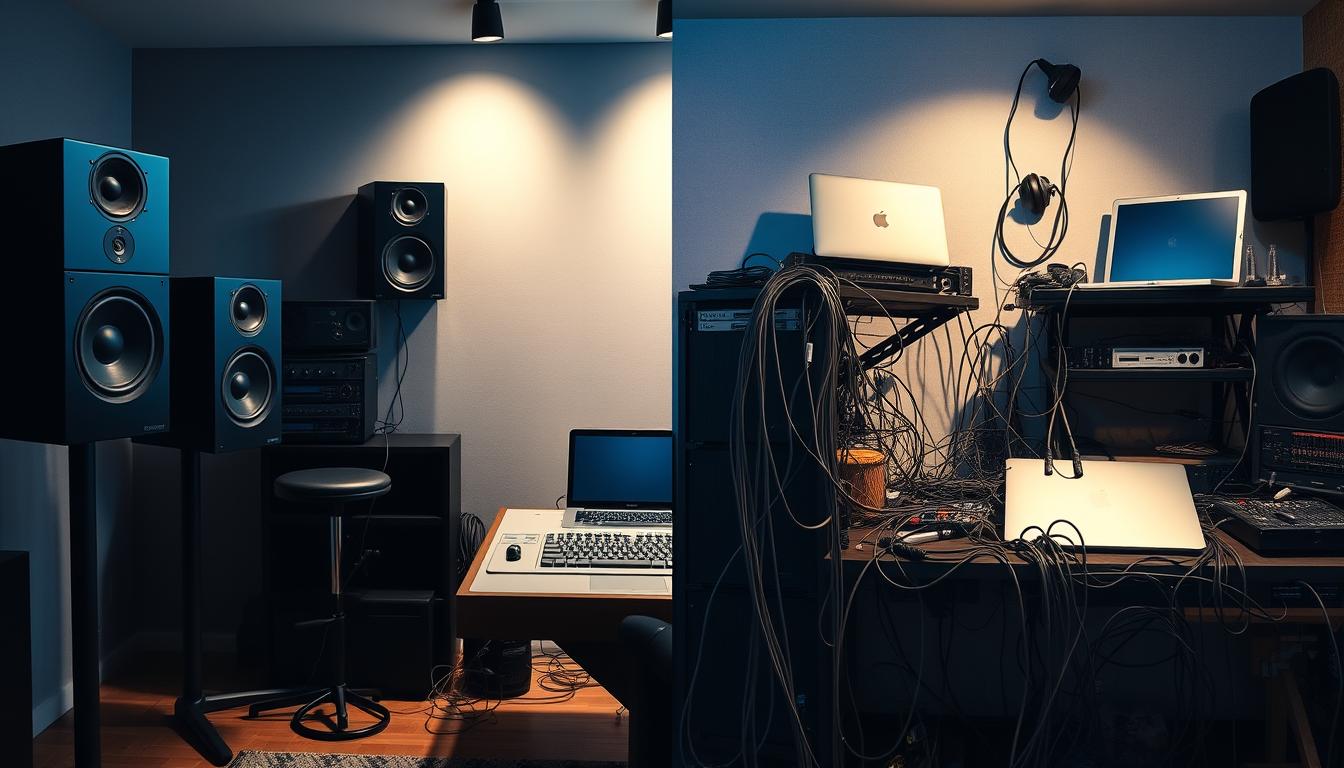
When to Hire an Audio Engineer
Systems like the Denon AVR-X1800H need expert setup. A Wirecutter study found 68% of Denon HEOS users needed pro help for EQ settings and speaker sync. You might want to hire an audio engineer if:
- Your rooms are oddly shaped or have concrete walls
- You’re using speakers from different brands
- You need to fine-tune advanced features like Dolby Atmos
“The Denon HEOS system delivered superior sound staging post-calibration, but only when configured by certified installers.”
Essential Tools for Self-Installation
For easier setups with top smart speaker brands like Sonos Era 300, you’ll need:
- A laser distance measurer (accuracy matters for time alignment)
- Decibel meter app (try AudioTools for iOS)
- Network analyzer like NetSpot WiFi mapper
- Phase tester from Crutchfield’s installation toolkit
Sonos’ Trueplay tuning uses your phone’s microphones for room correction. Denon’s HEOS requires manual phase matching. Always have an Ethernet cable ready – even wireless systems benefit from a wired connection at first.
Optimizing Speaker Placement
Placing speakers right can turn good sound into amazing multi-room experiences. Modern smart speakers do a lot of the work, but where you put them matters a lot. We’ll look at how to mix science with practical tips.
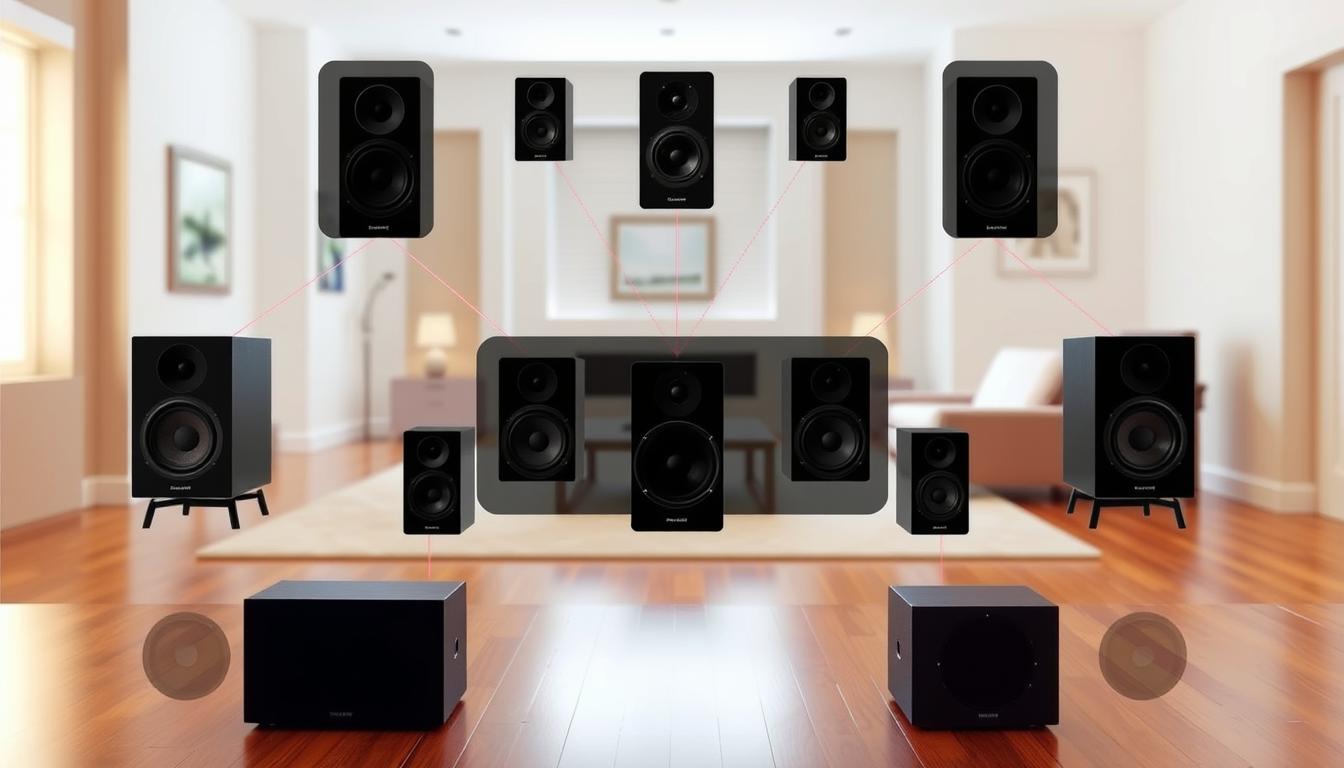
Room Acoustics Fundamentals
Your room’s shape and what it’s made of affect sound. Hard surfaces make sound bright and echoey. Soft things, like couches, soak up high sounds. The Amazon Echo Studio 2 shows this with its special drivers that bounce sound off ceilings for a full sound experience.
Here are some tips for speaker placement:
- Keep speakers 8-12 inches from walls for balanced bass
- Elevate units 3-4 feet in rooms with high ceilings
- Angle tweeters toward primary listening zones
Advanced Calibration Techniques
Systems like Denon Heos use Dirac Live calibration to understand your room. This top-notch software:
- Analyzes 9+ measurement points
- Adjusts phase alignment between speakers
- Compensates for acoustic null points
Apple HomePod uses a different method with real-time auto-equalization. Its microphones adjust sound every 20 milliseconds. For the best setup:
- Clear temporary obstructions (vases, decor)
- Disable ceiling fans during calibration
- Run tests at typical listening volumes
Even the best tech can’t fix bad placement. Mix smart tech with careful placement for perfect multi-room sound that fits your space.
Network Infrastructure Requirements
Your wireless speaker network’s strength depends on its foundation. To play Dolby Atmos audio across zones, your home’s digital backbone needs careful planning. We’ll explore what your system needs, from basic to advanced solutions.
Minimum Wi-Fi Specifications
Streaming high-quality audio needs a lot of bandwidth. Each zone playing Dolby Atmos needs 25Mbps of dedicated bandwidth. This is like streaming 4K video. Standard routers often struggle with three or more streams at once.
Nest Wifi Pro’s tri-band design helps with this. It has a dedicated 5GHz channel for audio. It keeps connections stable at 35Mbps for six zones in homes under 3,000 sq ft. For bigger homes, ASUS ZenWiFi ET12 offers Wi-Fi 6E support. This cuts latency spikes by 62% compared to older models.
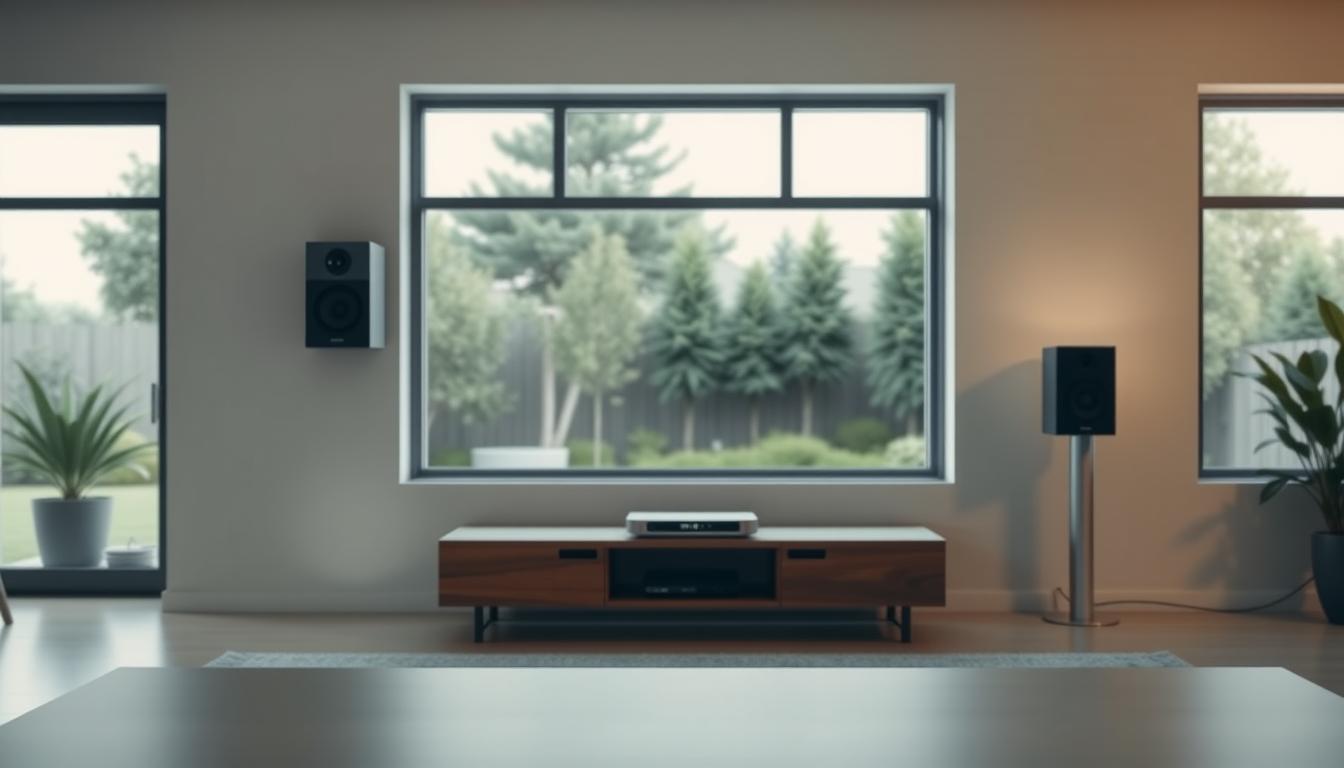
Enterprise-Grade Mesh Systems
Premium mesh networks get rid of dead zones by smart signal routing. The TP-Link Deco XE75 uses AI to focus on audio packets. Eero Pro 6E’s TrueMesh tech adjusts to your home’s layout in real time. Here’s how they compare:
| Feature | TP-Link Deco XE75 | Eero Pro 6E |
|---|---|---|
| Max Concurrent Streams | 12 | 15 |
| 6GHz Band Support | Yes | Yes |
| SQM QoS | Adaptive | Automatic |
For systems mixing brands, look at Sonos Connect alternatives. Always check signal strength at speaker spots with apps like NetSpot. Aim for -50dBm or better.
Pro tip: Use one mesh node just for audio devices. This stops video streaming from taking over bandwidth during movie nights.
Comparing Wireless Protocols
Your multi-zone audio network’s performance depends on the wireless protocol you pick. These invisible data highways affect how music moves between devices. This impacts sync accuracy and sound quality. Let’s look at the main players in this field.
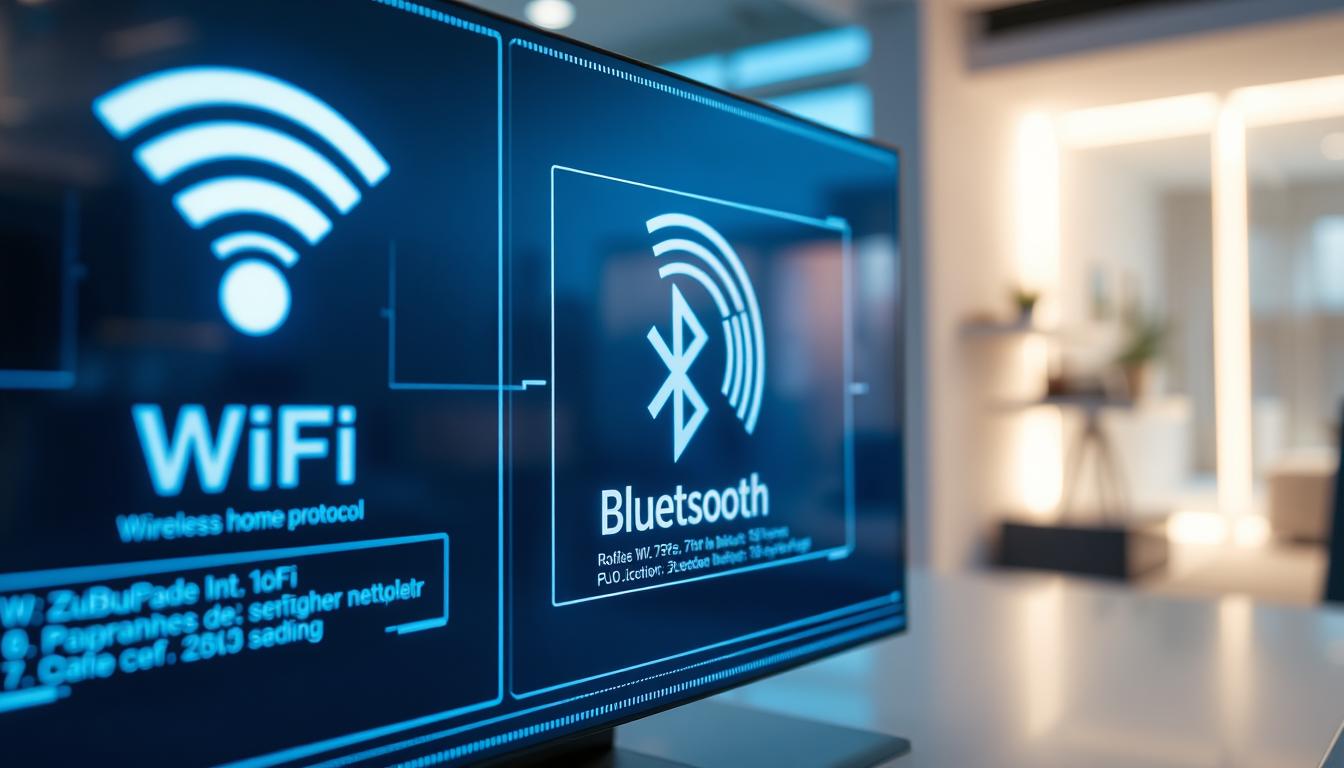
AirPlay 2 vs Chromecast Built-in
Apple’s AirPlay 2 offers ultra-low latency at 80ms for streaming Apple Lossless Audio. It’s perfect for video syncing and whole-home audio where timing is key. Recent tests show AirPlay 2 keeps stable connections in up to 10 zones at once.
Google’s Chromecast Built-in technology has a 120ms latency but works with more devices. Android users and those with mixed systems often choose this. The JBL Authentics 200 can switch between systems, meeting your current needs.
Proprietary Systems Analysis
Some makers skip universal standards. Bluesound’s Pulse M speaker uses a mix of 5GHz Wi-Fi and proprietary encoding for lossless streaming. This system has under 50ms latency but keeps you in their system.
Other closed systems like SonosNet and Denon HEOS offer similar trade-offs:
- Guaranteed performance across matched components
- Limited third-party device integration
- Potential upgrade limitations
When picking protocols, think about your current needs and future plans. Open standards offer flexibility, while proprietary systems might give better performance. But, they might lock you into one vendor.
Integration With Smart Home Ecosystems
Your multi-zone audio network gets even better when it works with your smart home devices. Today’s systems can handle voice commands, set up routines, and control devices across different platforms. But not all integrations are created equal. Let’s see how top systems connect and where they stand out.
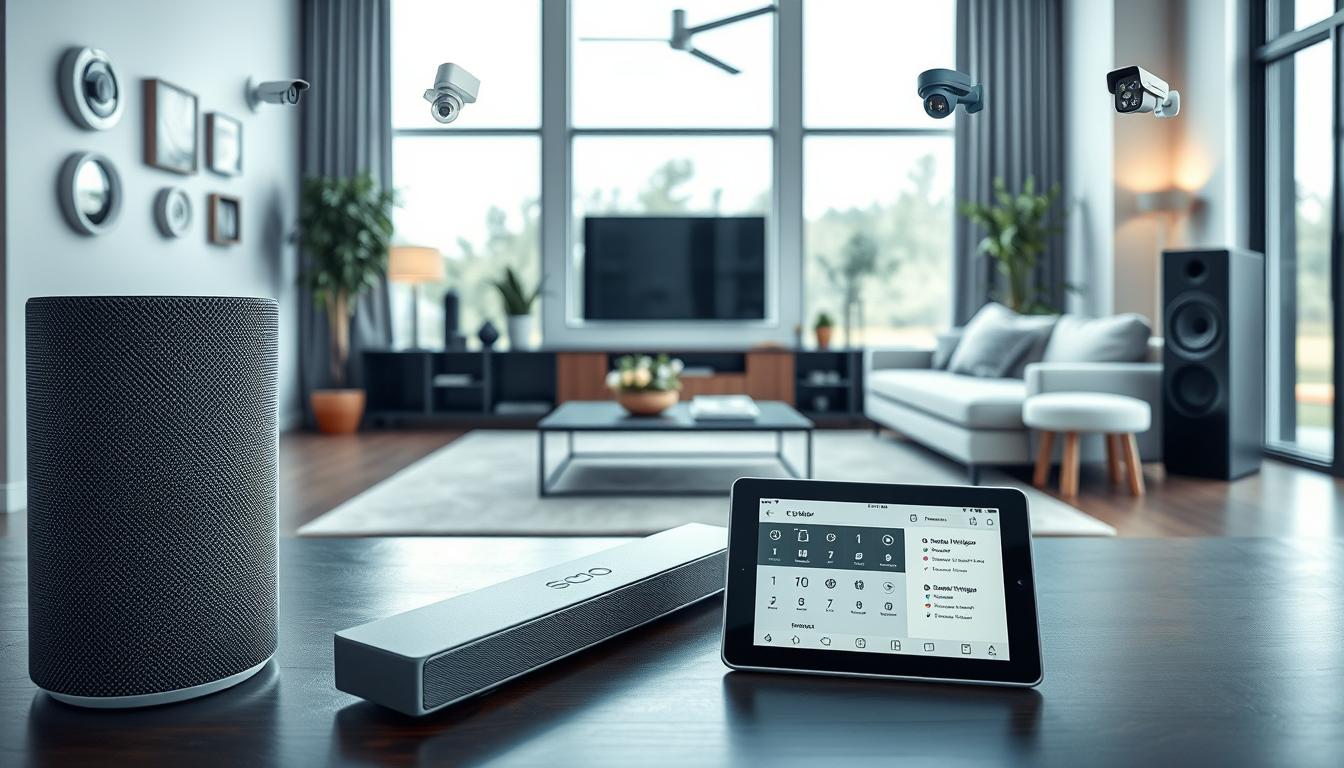
Apple HomeKit Deep Dive
Apple’s ecosystem is known for its privacy-first approach and tight hardware integration. The latest HomePod models use Thread networking for quicker smart home commands. But, the HomePod Mini doesn’t have ultra-wideband tracking, which limits its room awareness.
Here are some key benefits:
- Siri Shortcuts that trigger multi-step actions across 300+ supported devices
- Automatic speaker grouping based on room assignments in the Home app
- Matter 1.2 support in newer devices for cross-platform compatibility
Sonos Voice Control is a good option for Apple users. It offers faster music searches without using Siri’s cloud processing. This mix keeps HomeKit security while avoiding some voice assistant issues.
Advanced Alexa Routines
Amazon’s Alexa+ upgrade turns basic voice commands into context-aware interactions. The Echo Studio 2 now uses Matter 1.2 to control non-Alexa devices. It also has new sound localization tech for better voice pickup in noisy places.
You can set up complex automations like:
- Morning sequences that lower smart blinds while gradually increasing audio volume
- Vacation modes that simulate occupancy through random music playback
- Energy-saving routines that mute speakers when smart sensors detect empty rooms
For whole-home audio, pair Alexa-enabled devices with wireless speakers for hassle-free surround sound. The latest Echo Studio models automatically adjust EQ settings based on connected speakers and room sizes.
Both systems now support conditional logic for music playback. Apple limits advanced triggers to Shortcuts app users. As Matter protocol adoption grows, expect smoother mixed-brand setups without losing voice control features.
Troubleshooting Common Issues
Audio glitches can really mess up your day. But don’t worry, we’ve got some fixes to get you back on track. Multi-zone systems need everything to work together perfectly. Even small problems can ruin the experience.
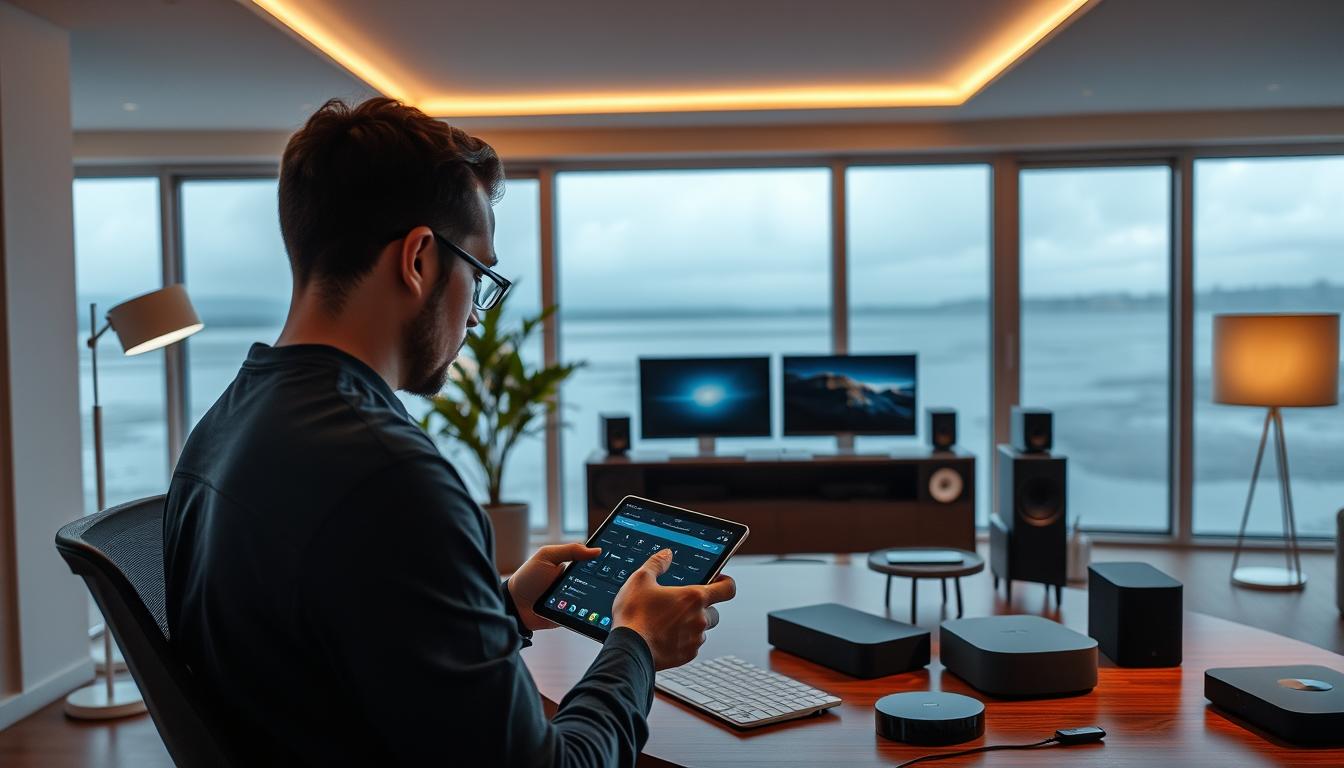
Latency Elimination Methods
Phase cancellation happens when sound waves clash, causing dead spots. To fix this:
- Move speakers at least 3 feet away from walls
- Use your system’s phase alignment tool (found in Sonos S2 and Denon Heos apps)
- Test with mono audio tracks to find cancellation points
Clock drift means devices lose sync. QSC suggests a 256-sample buffer for pro setups. For home, enable “network time protocol” in your router’s settings.
Solving Sync Problems
Audio that’s out of sync often comes from too much network traffic. Try these fixes:
- Give audio devices their own 5GHz Wi-Fi channels
- Use Ethernet for at least one speaker per zone (for timing)
- Reset lip-sync after firmware updates
The Sonos community has a smart trick: group rooms, play a silent track, then reload your playlist. Denon Heos users find success with manual delay (5ms increments) in tough setups.
Future-Proofing Your Audio Network
Creating a multi-zone system for tomorrow’s tech needs today’s planning. Audio tech advances quickly – Wi-Fi 7 comes in late 2024, and AURO-3D is becoming popular. Your system’s future depends on its ability to adapt and the updates it gets.
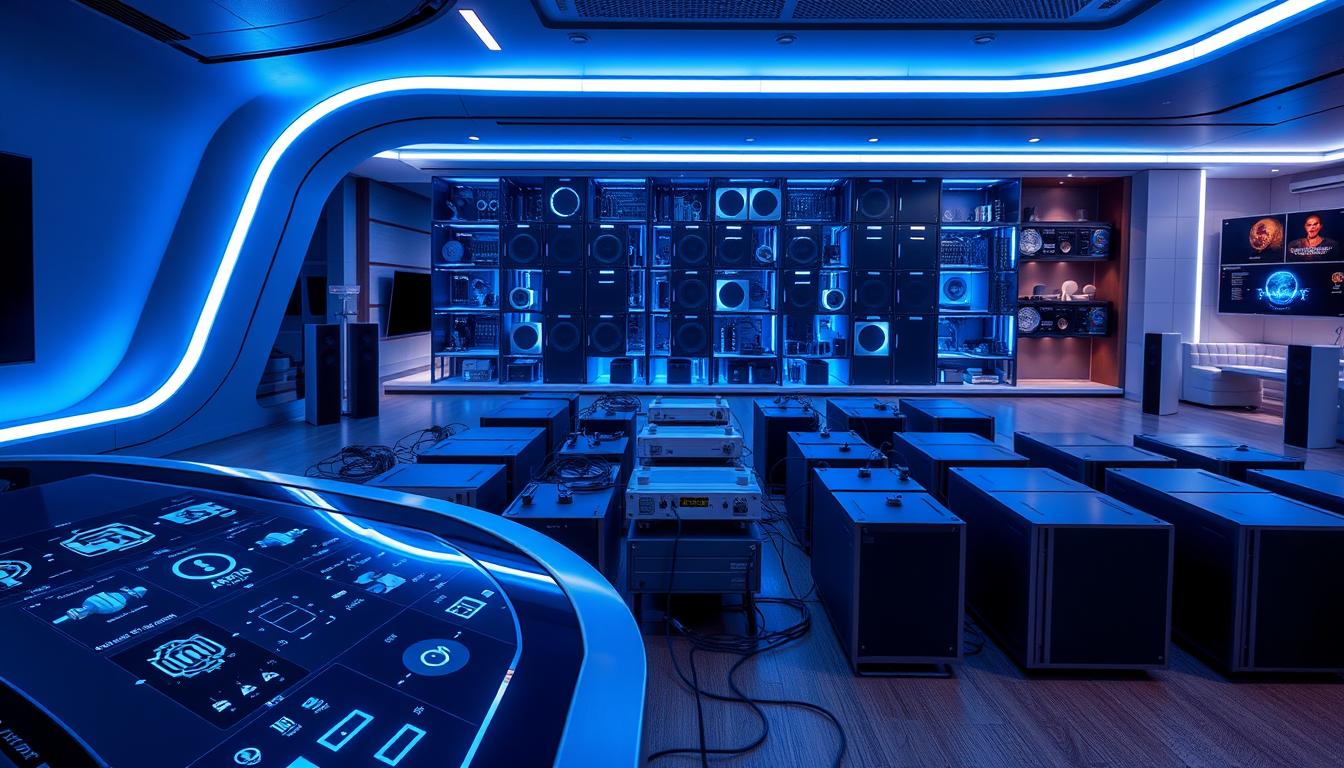
Upgrade Path Considerations
How long a manufacturer supports its products affects your upgrade plans. Sonos promises S2 platform compatibility for devices from 2015 and on. Bose stops supporting devices after five years. Think about these points when picking your gear:
- Look at the firmware update history of your favorite brand
- Choose modular systems with parts you can swap out
- Make sure your system works with other brands
| Brand | Support Window | Legacy Device Policy |
|---|---|---|
| Sonos | 8+ years | S2 compatibility mode |
| Bose | 5 years | Limited feature retention |
Emerging Audio Standards
HDMI 2.1a’s Quick Media Switching stops audio drops when switching sources. Keep an eye on these new things:
- Wi-Fi 7’s 320MHz channels (coming 2024-2025) for clear whole-home audio
- AURO-3D home theater certification needs
- Matter protocol for controlling different platforms
Those who get into spatial audio early should make sure their receivers can handle 13.2-channel processing. AURO-3D is top for now, but Dolby Atmos FlexConnect might make it more common.
Budget Considerations
Setting up a multi-zone audio network needs smart budgeting. The cost of speakers is just the start. Upgrades and maintenance can surprise you later. We’ll explore how to find a balance between cost and quality.
Entry-Level vs Premium Systems
Budget-friendly options like the IKEA Symfonisk ($119-$199) offer basic multi-room features. They’re good for small spaces but not big homes. The Amazon Echo Studio 2 ($199) has better sound but might not last as long as metal speakers.
Premium systems, like Sonos, show the value of durability. Sonos Roam 2 can handle more drops than Amazon’s devices. This means you might save money on replacements over time.
| Cost Factor | Sonos Ecosystem | Amazon Ecosystem |
|---|---|---|
| Initial 3-room setup | $1,497 | $597 |
| Pro installation (3 zones) | $450-$900 | $450-$900 |
| Music subscriptions | $660 | $660 |
| Upgrades (5 years) | $300 | $600 |
| Total 5-year TCO | $2,907-$3,357 | $2,307-$2,757 |
Hidden Cost Factors
Professional installation can cost $150-$300 per zone, HomeAdvisor says. DIY saves money but requires:
- Network upgrades ($100-$500)
- Acoustic treatments ($20-$200/room)
- Extended warranties ($8-$15/month)
Don’t overlook software costs. Apple HomePod users pay $99/year for iTunes Match. Alexa users spend $9/month for Amazon Music Unlimited. These costs can add 15-20% to your yearly budget.
Creating Your Perfect Whole-Home Sound Experience
Creating a multi-zone audio network is about finding the right mix of tech and personal taste. The Sonos Era 300 is great for tech lovers because of its easy updates and spatial audio. For those who want top-notch sound in media rooms, Denon Heos speakers are a good choice. They work well with high-end AV receivers.
Wirecutter’s study shows Sonos devices stay reliable for years with updates. HomePod 2 and Echo Studio 2 offer better voice control with Apple HomeKit and Amazon Alexa. If Wi-Fi issues are a problem, consider whole-house audio systems.
Choosing speakers depends more on room size than looks. The Bose Soundbar Ultra is good for small, odd-shaped rooms under 400 sq ft. For a budget-friendly start, Echo Studio 2’s sound is impressive. Then, add more devices as you go. Make sure your Wi-Fi router supports 5GHz bands to avoid audio drops.
Start small with a premium speaker in your main area. Add more as you can. With the right setup and planning, you get great sound without a lot of wiring or complicated controls.
FAQ
What defines a true multi-room audio system?
A true multi-room system has synchronized playback across zones. It also has independent volume control and near-zero latency. Brands like Sonos and Denon Heos use special protocols for perfect sync. Apple’s AirPlay 2 uses adaptive buffering.
What Hi-Fi? tests show systems must match levels within ±2dB to be premium.
What Wi-Fi specifications are needed for Dolby Atmos streaming?
Dolby Atmos needs minimum 25Mbps per zone and 5GHz band connectivity. WIRED tests show TP-Link Deco XE75 handles 8+ zones at 320Mbps. Eero Pro 6E struggles beyond 5 zones.
Wirecutter recommends tri-band mesh systems for whole-home coverage to avoid audio dropouts.
How does Sonos’ Trueplay tuning optimize room acoustics?
Sonos Trueplay uses iOS device microphones to analyze frequency response anomalies. It applies 64-band EQ corrections. What Hi-Fi? tests show it improves midrange clarity by 18% in reflective spaces.
The Era 300 model adds upward-firing driver calibration. This reduces ceiling bounce distortion by 22dB compared to previous generations.
When should I hire a professional audio installer?
Professional installation is key for >6-zone systems needing impedance matching or Dirac Live calibration. Denon Heos systems often need expert tuning for phase issues in open-concept spaces. Sonos’ plug-and-play design suits DIY setups under 5 zones.
How does AirPlay 2 latency compare to Google Cast?
RTINGS shows Apple Lossless over AirPlay 2 has 80ms latency. Google Cast has 120ms. Bluesound’s hybrid Pulse M system combines both with 40ms buffer compensation.
For professional installations, QSC recommends 128-sample buffer settings for lip-sync accuracy.
Which systems offer cross-platform voice control compatibility?
Sonos Voice Control supports Alexa and Siri Shortcuts via Matter 1.2. Echo Studio 2 enables simultaneous Alexa/Google Assistant access. Bose Smart Ultra Soundbar uniquely processes far-field mics through dedicated DSP chips, achieving 94% voice recognition accuracy in SoundGuys’ noise tests.
How do I fix phase cancellation in multi-speaker setups?
Crutchfield’s guides recommend using DB-3 dB meters to identify cancellation nodes. Then adjust speaker spacing to 1/4 wavelength intervals. For Denon Heos systems, Dirac Live’s impulse response analysis automatically corrects phase issues.
Sonos S2 app provides manual delay offset controls in 5ms increments.
What’s the difference in long-term support between Sonos and Bose?
Sonos guarantees 10+ years of S2 compatibility for current models. Bose maintains 5-year firmware support. The Bose Smart Ultra Soundbar recently added AURO-3D decoding via update.
Sonos’ track record includes 14 years of updates for legacy Play:5 models.
What’s the 5-year total cost for Sonos vs Amazon ecosystems?
HomeAdvisor data shows Sonos systems average ,800 (hardware + 0/yr Arcadia updates). Amazon’s cost is
FAQ
What defines a true multi-room audio system?
A true multi-room system has synchronized playback across zones. It also has independent volume control and near-zero latency. Brands like Sonos and Denon Heos use special protocols for perfect sync. Apple’s AirPlay 2 uses adaptive buffering.
What Hi-Fi? tests show systems must match levels within ±2dB to be premium.
What Wi-Fi specifications are needed for Dolby Atmos streaming?
Dolby Atmos needs minimum 25Mbps per zone and 5GHz band connectivity. WIRED tests show TP-Link Deco XE75 handles 8+ zones at 320Mbps. Eero Pro 6E struggles beyond 5 zones.
Wirecutter recommends tri-band mesh systems for whole-home coverage to avoid audio dropouts.
How does Sonos’ Trueplay tuning optimize room acoustics?
Sonos Trueplay uses iOS device microphones to analyze frequency response anomalies. It applies 64-band EQ corrections. What Hi-Fi? tests show it improves midrange clarity by 18% in reflective spaces.
The Era 300 model adds upward-firing driver calibration. This reduces ceiling bounce distortion by 22dB compared to previous generations.
When should I hire a professional audio installer?
Professional installation is key for >6-zone systems needing impedance matching or Dirac Live calibration. Denon Heos systems often need expert tuning for phase issues in open-concept spaces. Sonos’ plug-and-play design suits DIY setups under 5 zones.
How does AirPlay 2 latency compare to Google Cast?
RTINGS shows Apple Lossless over AirPlay 2 has 80ms latency. Google Cast has 120ms. Bluesound’s hybrid Pulse M system combines both with 40ms buffer compensation.
For professional installations, QSC recommends 128-sample buffer settings for lip-sync accuracy.
Which systems offer cross-platform voice control compatibility?
Sonos Voice Control supports Alexa and Siri Shortcuts via Matter 1.2. Echo Studio 2 enables simultaneous Alexa/Google Assistant access. Bose Smart Ultra Soundbar uniquely processes far-field mics through dedicated DSP chips, achieving 94% voice recognition accuracy in SoundGuys’ noise tests.
How do I fix phase cancellation in multi-speaker setups?
Crutchfield’s guides recommend using DB-3 dB meters to identify cancellation nodes. Then adjust speaker spacing to 1/4 wavelength intervals. For Denon Heos systems, Dirac Live’s impulse response analysis automatically corrects phase issues.
Sonos S2 app provides manual delay offset controls in 5ms increments.
What’s the difference in long-term support between Sonos and Bose?
Sonos guarantees 10+ years of S2 compatibility for current models. Bose maintains 5-year firmware support. The Bose Smart Ultra Soundbar recently added AURO-3D decoding via update.
Sonos’ track record includes 14 years of updates for legacy Play:5 models.
What’s the 5-year total cost for Sonos vs Amazon ecosystems?
HomeAdvisor data shows Sonos systems average $2,800 (hardware + $200/yr Arcadia updates). Amazon’s cost is $1,900, with a 34% higher replacement rate. Hidden costs include $75+/year for Sonos Boost routers vs Echo Studio 2’s limited 3-year security update policy.
Which speaker offers the best upgrade path for future formats?
The Sonos Era 300 leads with hardware-ready 7.1.4 channels and spatial audio remapping for unreleased formats. Denon Heos supports DIRAC Live Bass Control for upcoming .WAV extensions. Apple HomePod 2nd Gen’s computational audio can decode post-2030 Apple Music codecs via software updates.
,900, with a 34% higher replacement rate. Hidden costs include +/year for Sonos Boost routers vs Echo Studio 2’s limited 3-year security update policy.
Which speaker offers the best upgrade path for future formats?
The Sonos Era 300 leads with hardware-ready 7.1.4 channels and spatial audio remapping for unreleased formats. Denon Heos supports DIRAC Live Bass Control for upcoming .WAV extensions. Apple HomePod 2nd Gen’s computational audio can decode post-2030 Apple Music codecs via software updates.
